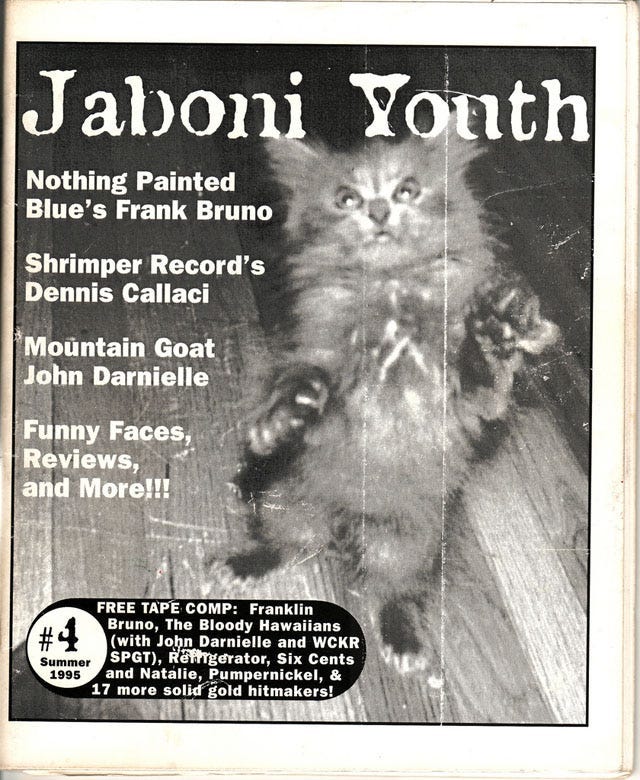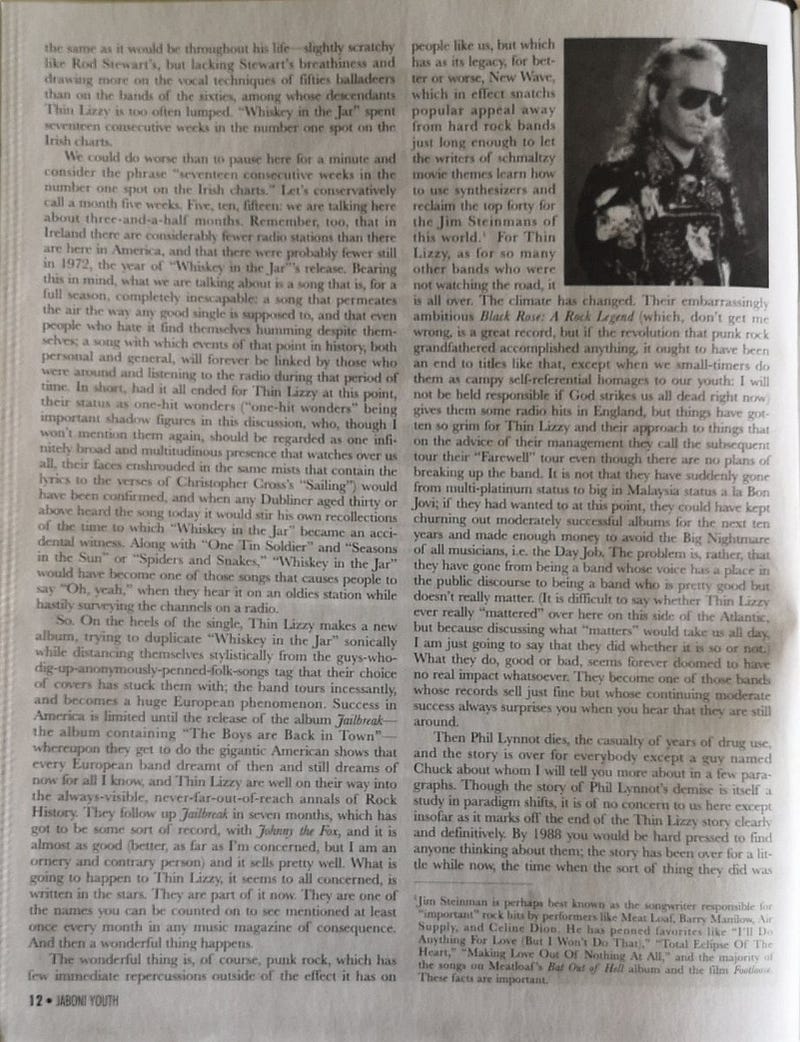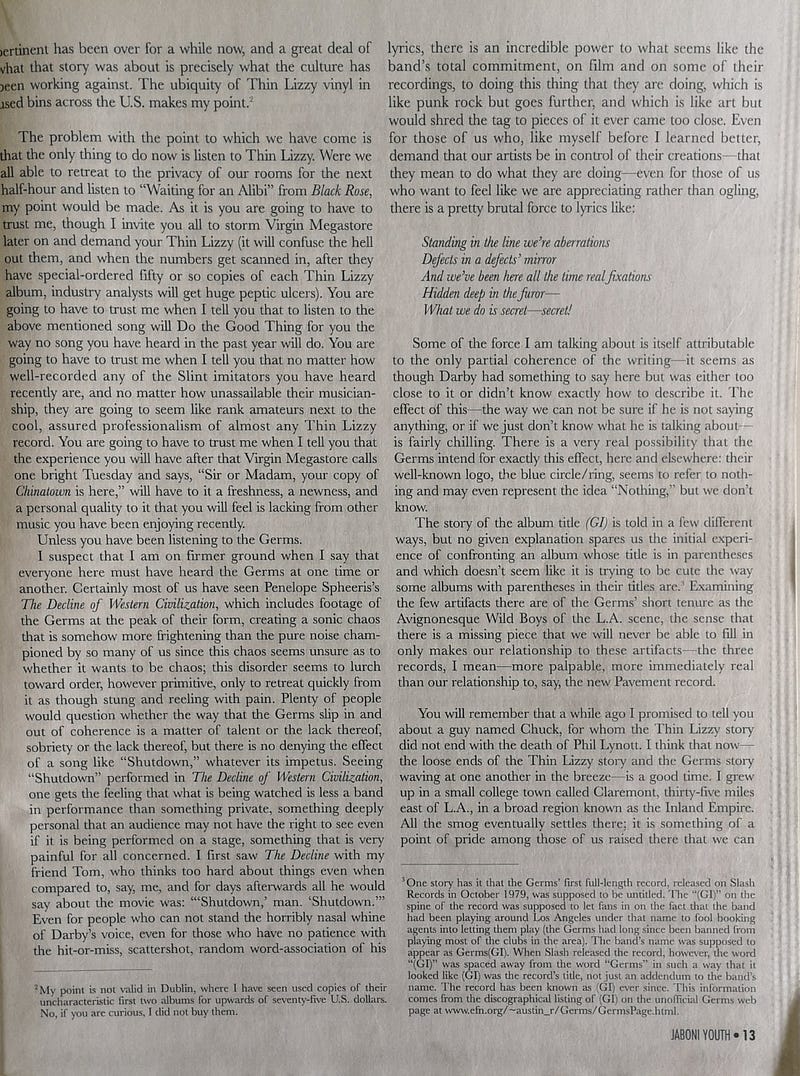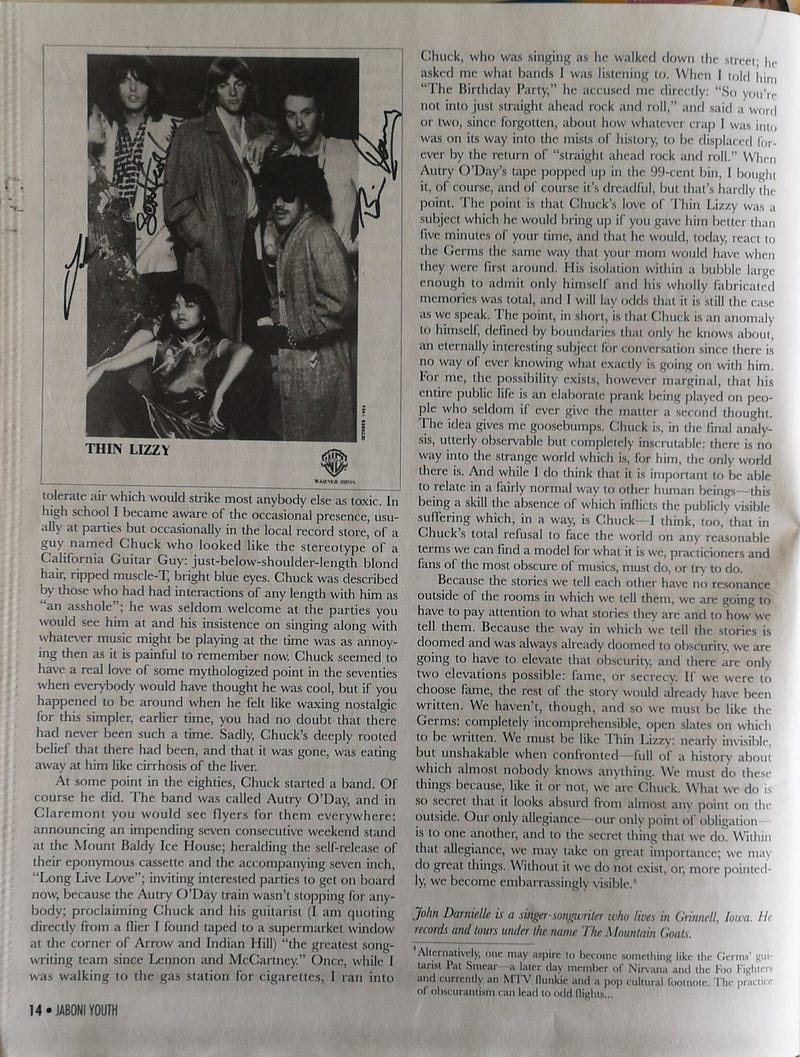Zineage Kicks: Jaboni Youth
An interview about my teenage zine with The Guardian's Laura Snapes for her blog
This interview about my old zine Jaboni Youth was published in a briefly-extant Tumblr called Zineage Kicks run by the excellent music journalist Laura Snapes. I’ve been suffering from nostalgia of late for various reasons — and thought I’d make sure it had a place on the web. Laura is the questioner and her words are in italics.
These days, Alec is best known for running Brassland Records alongside Aaron and Bryce Dessner from The National, in addition to managing Chk Chk Chk. In the past, he managed Dirty Projectors, and wrote some incredible articles for LA Weekly (including this key piece on Elliott Smith).1 Prior to that, in the year before he started studying at Yale, he ran fabled fanzine (and cassette label, the nascent Brassland) Jaboni Youth, which counted The Mountain Goats’ John Darnielle amongst its contributors.
Here, Alec talks in-depth about the fanzine’s inception and lifespan. And in honour of his fine work, I vote we try our utmost to get the term “jaboni” back into common parlance as soon as possible. And bookmark his blog,2 it’s excellent.
Where did the name come from?
Throughout high school, my best friend was a dude named Mark Ospovat. Mark was a few years younger than me, but his father had had him very late in life — I believe Mark’s dad was in his 70s by the time we met. Therefore, the words that sometimes came out of his father’s mouth were a snapshot of an earlier time. At one point, after some youthful idiocy, as Mark and I sat in the in the driveway preparing to get away in whatever vehicle we had convinced our parents to lend us, his father stood in the archway of the front door, shaking his fist at us and screaming “You stupid jabonis!”
What was that youthful indiscretion? Maybe we had stayed out way too late the night before? Maybe we’d spent the afternoon polishing off a dozen donuts and gotten sick all over the guest bathroom? Maybe one of us had burnt a hole in the kitchen sink after setting a titanium ribbon aflame? Maybe one of us had used up all the toner in the family’s home office photocopier?
It’s hard to say. It was a long time ago.
In any case, the name was warranted & appropriate.
When and why did you set the zine up?
I believe I started it during a gap year I took — after I’d graduated from high school but before I began college.
Jaboni Youth was the expression of three conditions. (1) I lived in the suburbs and I was bored & longing for human connection. (2) I was excited about underground music & culture. And I was (3) even more logorrheic than I am today.
I continued it throughout my four years of college. It fulfilled the role of introducing me to a world beyond the world I lived in at the time. I hope and expect that desire to interact with other people through culture will never change.
You told me previously that you had “no friends” when you were making it. Is that really true?! Some googling would suggest that it led you to now-Pitchfork writer Brandon Stosuy, who you still appear to be good friends with — did it help foster a community at school/college for you?
Geez, Laura, “No friends” is a rather extreme way of putting it! I definitely had a posse of boys & girls I hung out with — mostly local misfits & participants in the emerging alternative culture of the day. (The scene I was involved in back then played out pre- and post-Nirvana, who were a real & significant mile-marker at the time.) These people were the rebel children of various first generation immigrants; dissatisfied scions of the Scarsdale, NY, bourgeois whose hatred of their upbringing mostly expressed itself in subcultures like skateboarding and punk rock; and various troubled street urchins who we were drawn to & who were drawn to us. Actually, I’m not sure who I’m referring to with that “us”; I might have been one of the urchins.
We were united by a common interest in what we called “ruckus” & other forms of beautiful noise.
What kind of distribution and reputation did the zine have (or in the case of the latter, did you think/hope it had)? How regularly did it come out, how did you get it out to the public?
I can’t answer the question about reputation authoritatively as it’s somewhat lost to the mists of time. Once or twice, I have bumped into people who remember it fondly. I half-recall a famous Riot Grrrl asking me about it when I was interacting with her as a “real” journalist many years later. (I think it was Maggie Vail or, heavens to betsy, maybe it was even Tobi asking me if I was the same Alec that did Jaboni Youth?)
In terms of getting the thing out into the world, I remember that at the time the paragon of successful zine publishing was to gain distribution in the Tower Records chain, who would take (and sell!) upwards of a thousand copies of a good zine. By the third (or fourth?) issue I think I achieved that distinction. There may have been some smaller distributors as well. The last issue also had some free distribution around the college town I was living in. The early issues were distributed to a few dozen people by mail. I think the zine “sold” for however many stamps it took to send it. By the end of the zine’s run, I remember being pretty fed up with the tedious demands of mail-order and I’m not sure it was available anywhere but in stores and newsstands. I managed to publish about an issue a year for about five years time.
Was it a DIY photocopying job?
Yep, at first. I made copies at my mother’s place of business. Later on the aforementioned home office photocopier of Mark Ospovat’s father. By the third issue, I think I’d graduated to an advanced photocopier at my university’s print shop, an early example of “print-on-demand” technology. Later issues used regular offset printing. I think I managed to produce two issues that way.
The design of the few pages I’ve seen is pretty great — did you do that too?
Well thank you, I don’t remember it being nearly as great as you do! Since I’m not quite sure where I’d find any copies of the thing at this point, I’ll let your memory supersede my own, less glowing reminisce.
In any case, I can’t take all the credit for the design. I believe the later issues were designed by (or at least heavily enabled) by my housemate throughout college Gabriel Snyder.
Did you have a particular remit, a swathe of music that you covered?
As the Californians I was being introduced to throughout college might have put it: “Hells no.”
The zine was really an exploratory device. I’d say I mostly covered what you’d broadly term “indie rock” — punk rock, singer-songwriters trying to mask their identities, and some weirder experimental noises. I remember a kind of music that was “lo-fidelity” being given a lot of attention. At the time that included singer-songwriter savants like Elliott Smith and Smog. The only genres that I don’t think I touched upon all that much was electronic music and classical (unless you’d consider Rachel’s classical). And, of course, anything R&B and hip-hop-oriented was probably given short shrift. In retrospect it makes me really, really really sad I did not capture my 20-something musings on Biggie Smalls.
Which features/items that you ran do you look back on fondly now?
I honestly don’t remember most of what was in the zine so it would be inaccurate to say I think back on anything in it with fondness! I do remember being excited at having the chance — however briefly or shallowly — of connecting with some of my favorite musicians. I also remember being intently focused on reviewing every piece of music I managed to get into my collection, back when having a record collection was a real badge of distinction. (What kind of distinction I’m not sure.)
However, the fondness I feel isn’t for the reviews themselves or the task of writing; it’s for the purchase of the albums themselves. Back then there was a real joy in blowing $100 on a compact disc shopping spree, coming home with ten or twenty discrete objects to be unpacked and absorbed over the weeks and months to come. Nowadays it’s hard to imagine being so excited about a compact disc (and occasional 7”)!
It took a long time for me to figure out that this was the exact wrong way that a listener should experience music. I know I’m sort of hinting at a fuller response here, but I’ll let this incomplete answer just hang in space…
What was the “Funny Faces” item?
I think that was a feature that ran in one issue. It was photographs of musicians making funny faces. The only explanation I can come up with for why and how it happened is that it was a good way to break the ice with musicians I wanted to meet.
Was it a solo project? Who did you collaborate on it with if not?
I guess I could call it a solo project, but I definitely published a fair bit of work by other people, especially in the later issues. For example, John Darnielle from the Mountain Goats, the designer Andrew Kuo who has gained some renown for his music-related charts in The New York Times, this brilliant fellow named Jason Morphew who I fall in and out of touch with, and this dude Brian Doherty who (after Googling him) is apparently a senior editor at the libertarian magazine Reason.

Am I right in thinking it was also a cassette label? If so, how did the two relate? I remember you saying that somewhere along the line, Jaboni Youth became Brassland, or at least sowed the seeds for it — how did the transition happen?
In high school I ran a cassette label with Mark Ospovat, the friend mentioned earlier in this interview. I will leave it to you to try to find the original name for it (while secretly hoping that it is lost to the vagaries of a pre-Google universe). [I tried, and I can’t find it. Your secret’s safe — Laura]
When I moved away to go to college, Mark and I weren’t collaborating anymore so I renamed it Brassland and kept some of my favorite cassettes in print. When I graduated in the late ’90s, I embarked upon a few years of typical post-collegiate searching and that name lay dormant for a few years.
I’m sure what I said about the evolution from zine to label is true — but I’ll be damned if I can recall the details. Doing this interview prompted me to read an old interview I did in my college newspaper at the time I published Jaboni Youth’s last issue. In it, I said “I might be helping some friends of mine start an indie record label.” But in terms of the timeline I have in my head, that seems too early for me to have been considering a label with Aaron and Bryce Dessner because The National and Clogs hadn’t even formed yet.
Explain John Darnielle’s involvement with the tape side of things, what did he write for you?
One of the later issues of the zine included a tape compilation. John contributed a song from a side project of his called the Bloody Hawaiians and, in the zine itself, I published a short essay of his called ‘The Value of Overstating the Obvious’. I’m not sure if he was doing much writing at the time, but I remember it being good enough that, should he ever win the MacArthur Award he is destined for, I hope that whoever edits together the inevitable ‘Collected John Darnielle Anthology’ manages to dig that essay up and reprint it.

Do you think there’s still a point to, or role for zines these days?
I’d say that question deserves a whole essay in response but I’m not the guy who is going to write it. Instead, I’ll offer a few strands.
My short answer would be “No — at least in the role that I think zines fulfill. Technology has made it possible to do the same job in more efficient, inspiring and profoundly communicative ways.”
To unpack that pretentious little nugget a bit: in those pre-internet days, zines were the most direct and lively way for folks otherwise off-the-grid to assert an identity, and participate in culture, and to meet other people interested in the same kind of things. Now there are better ways. In term of efficiency, I won’t pretend I understand the relative carbon footprints of printing a few thousand copies of a small magazine vs. publishing things onto the internet — but it does seem like the potential audience of a printed zine isn’t really justified when you consider the potential waste of the many copies that might go unread.
I guess zines are still interesting for people who are particularly fascinated by things that are made by hand or in a limited edition, but that was not my primary interest. Maybe that’s already obvious from my description of Jaboni Youth’s evolution from a hand written, photocopied and assembled thing to a professional, offset printed magazine. By the way, sorry that I came up with such a boring way to end this interview. Maybe the boredom will inspire someone the same way it did me.
Originally published around 2012 in the Zineage Kicks Tumblr account
Here is a second piece I wrote about Elliott Smith after his death:
Sleepwalker: Elliott Smith’s unhappy dream life
Q: “It seems as if there was a time when people were worried about Elliott Smith. Do you think that time is passed?” Elliott Smith: “Yeah, that time is passed.” — 2000 interview transcript A SONIC THING THAT HAS NO REAL FACE In 2000, I met Elliott Smith several times over a three-day span for a profile in this paper. But the first time we really spoke was …
It was also written for the LA Weekly which trashed their archives after an ownership change. Thus this version now housed on this Substack-fueled mixtape delivery service.
At the time this Tumblr interview with Laura Snapes was published I believe I had an occasional blog I ran at a subdomain of my label’s brassland.org website. However the contents of that have long ago been lost/destroyed/burned (lol). This mixtape delivery service you are on now is now my blog I guess?









